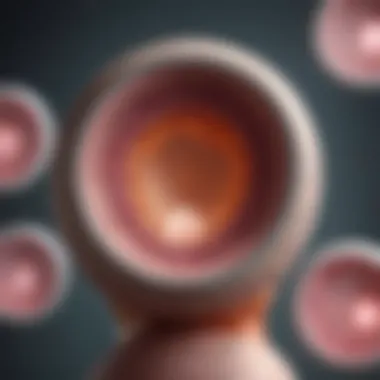Understanding Ovulation Timing: Insights for Fertility


Intro
Understanding the complexities of ovulation is vital for women, particularly for those trying to conceive or monitoring their reproductive health. Ovulation marks a significant phase in the menstrual cycle when an ovary releases an egg, making it a key contributor to fertility. This article aims to explore various aspects of ovulation, including the timing and underlying physiological processes that dictate this natural event.
Accurate knowledge of ovulation can positively impact fertility awareness. By recognizing the signs of ovulation, women can optimize the chances of conception. Additionally, it is essential to comprehend how various factors, such as hormones and lifestyle choices, can influence the regularity and functioning of the ovulation cycle.
In this examination, the focus will be on the hormonal regulation of ovulation, how different factors can alter an individual's cycle, and the implications of understanding ovulation for broader reproductive health. A thorough understanding of these elements grants women deeper insights into their bodies, thus equipping them with the necessary tools to navigate their reproductive journeys more effectively.
Preamble to Ovulation
Understanding ovulation is essential for comprehending female reproductive health. This process plays a key role in fertility and has profound implications for women’s overall well-being. Ovulation, the release of an egg from the ovaries, is part of the menstrual cycle and directly influences menstruation, pregnancy, and even hormonal balance.
Grasping the concepts surrounding ovulation helps women track their cycles accurately, which can inform family planning decisions. Knowledge of ovulation empowers women to identify fertile windows for conception or to understand the physiological changes that occur in their bodies.
Moreover, the understanding of ovulation is not only beneficial for those seeking pregnancy. It can also aid in recognizing irregularities in menstrual cycles. By becoming aware of one's own ovulation patterns, women can detect potential health issues early, such as hormonal imbalances. Thus, this topic is not merely academic; it has real-world applications that can shape individual health strategies.
Definition of Ovulation
Ovulation specifically refers to the phase in the menstrual cycle when a mature egg is released from the ovarian follicle. This event typically occurs around the midpoint of the cycle, about 14 days before the onset of menstruation. The egg then travels down the fallopian tube, where it may be fertilized by sperm, leading potentially to pregnancy. If fertilization does not occur, the uterine lining is shed during menstruation.
The timing and regularity of ovulation can vary significantly among women, influenced by various factors such as age and health status. Understanding ovulation gives insight into the reproductive process, enhancing awareness about the body's natural rhythms.
Historical Perspectives on Ovulation
Historically, the understanding of ovulation has evolved considerably. Early references to ovulation can be found in ancient texts where reproductive processes were often linked to beliefs about fertility and the lunar cycle. However, scientific exploration into this domain began in earnest in the 19th and 20th centuries.
In the late 19th century, reproductive biologists started to outline the physiological events surrounding ovulation. The advent of microscopy allowed for deeper observations of ovarian activity. By the mid-20th century, hormonal roles became clearer, especially regarding estrogen and progesterone, which regulate ovulation. Research continued to reveal how complex interactions between hormones dictate not only ovulation but also broader aspects of reproductive ecology.
In modern times, ovulation is discussed not only as a biological phenomenon but also in the context of reproductive rights and health. Understanding the intricacies of ovulation now drives personal health choices, medical advancements, and educational efforts regarding fertility, making its study ever more relevant in today’s society.
The Ovulation Cycle
The ovulation cycle is essential for understanding female reproductive health. It encapsulates the physiological processes that a woman's body undergoes each month, preparing for potential conception. Knowledge of this cycle enhances awareness of one’s body, aids in family planning efforts, and can be pivotal in identifying health issues. By examining the specific phases and hormonal regulations involved, individuals can make informed decisions related to fertility and reproductive management.
Phases of the Menstrual Cycle
Follicular Phase
The follicular phase varies greatly among individuals but typically lasts from the first day of menstruation until ovulation. This phase is marked by the maturation of ovarian follicles, one of which will eventually release an egg. Key characteristics include rising estrogen levels, which stimulate the growth of the uterine lining. Understanding this phase is beneficial as it sets the stage for ovulation. Unique features include the development of multiple follicles, although usually, only one fully matures, leading to ovulation. The advantages of this phase involve preparation for conception and overall hormonal balance.
Ovulation Phase
The ovulation phase is the point in the menstrual cycle when a mature egg is released from the ovary. This typically occurs about midway through the cycle and is triggered by a surge in luteinizing hormone. This phase is pivotal, as it represents the only time a woman can conceive during her cycle. A primary characteristic is the exact timing of ovulation, influenced by various factors, including cycle length. The unique aspect of this phase is the precise hormonal interplay that dictates ovulation. While the potential for conception is the advantage of this phase, irregular cycles can create challenges in pinpointing the most fertile days.
Luteal Phase


The luteal phase follows ovulation and generally lasts about 14 days. It is characterized by the secretion of progesterone, a hormone crucial for maintaining a potential pregnancy. During this time, the uterine lining continues to thicken, preparing for possible implantation of a fertilized egg. This phase is beneficial as it supports early pregnancy signs and fosters a suitable environment for implantation. A significant aspect is its relatively fixed duration; unlike other phases, it usually lasts a consistent length, making tracking cycles easier. However, its disadvantage can arise if pregnancy does not occur, leading to hormonal withdrawal and menstruation.
Hormonal Regulation of Ovulation
Role of Estrogen
Estrogen plays a crucial role in the menstrual cycle. It is primarily produced in the ovaries and is important for developing the follicles during the follicular phase. A key characteristic is its ability to promote the growth of the uterine lining, facilitating an ideal environment for a fertilized egg. The advantage of estrogen is its dual role: it prepares the body for ovulation and supports the early stages of pregnancy if conception occurs.
Function of Progesterone
Progesterone is essential during the luteal phase of the ovulation cycle. Its primary function is to regulate the uterine lining, ensuring it remains thick and supportive. A key characteristic is its production by the corpus luteum, which forms post-ovulation. This hormone's presence is beneficial as it helps maintain a potential pregnancy. However, its decline if pregnancy does not occur leads to menstruation, which can be seen as a disadvantage for those wanting to conceive.
Impact of Luteinizing Hormone (LH)
Luteinizing hormone is vital during the ovulation phase. It is indicative of ovulation itself as levels surge, prompting the release of an egg. A primary characteristic of LH is its timing; its peak indicates the right moment for conception. This hormone is beneficial for understanding fertility windows, as monitoring LH levels can help predict ovulation. However, various factors, such as stress or health issues, can affect LH levels, complicating tracking and understanding ovulation.
Timing of Ovulation
The timing of ovulation plays a critical role in the reproductive process and understanding it can significantly enhance fertility awareness. The day of ovulation is typically the most fertile time in a woman’s cycle. Recognizing the specific timing allows for better planning for conception or, conversely, for effective contraception. This section evaluates the typical timing of ovulation and the variability that can occur in menstrual cycles, both of which are vital to grasp for those interested in reproductive health.
Typical Ovulation Timing
Ovulation usually occurs midway through a woman’s menstrual cycle. For those with a regular cycle of 28 days, ovulation often happens around day 14, counting from the first day of the last menstrual period. However, understanding this timing is not absolute, as several variables may influence it. Factors such as cycle length, hormonal balance, and overall health can shift ovulation timings. It is crucial for individuals looking to conceive or avoid pregnancy to monitor ovulation signs or utilize ovulation tracking tools. This can ensure they have accurate information relevant to their unique cycle patterns.
Menstrual Cycle Variability
Variability is inherent in menstrual cycles, and several aspects contribute to this.
Cycle Length Variability
Cycle length variability refers to the differences in the number of days in women’s menstrual cycles. Normal cycles can last from 21 to 35 days. Women with longer cycles may ovulate later than those with shorter cycles.
- Key Characteristics: Many women experience variability, which can stem from stress, lifestyle factors, or health conditions.
- Benefits: Recognizing cycle length variability helps women understand their ovulation better, aiding in conception plans or avoidance.
- Disadvantages: Increased variability may make it challenging to pinpoint ovulation, requiring more careful tracking and observation.
Early and Late Ovulation
Early and late ovulation are significant factors that play into the timing of ovulation.
- Key Characteristics: Early ovulation may occur in cycles shorter than the standard 21 days, while late ovulation typically happens in longer cycles.
- Benefits: Understanding whether one ovulates early or late can help in timing intercourse for conception. It can also be vital for recognizing signs of hormone imbalance or health issues.
- Disadvantages: Sometimes, early or late ovulation can lead to difficulties in conception and may require medical consultation for obvious concerns.
"With understanding the timing of ovulation, one can take proactive steps toward achieving their reproductive goals."
In summary, having a grasp on the timing of ovulation, including the typical timing and the variability in menstrual cycles, is essential for reproductive health. Women must consider monitoring their cycles closely to gather the most accurate information about their ovulation signs.
Factors Affecting Ovulation Time
Understanding factors that influence ovulation time is essential for women who want to grasp their reproductive health better. Here, we explore how age, health conditions, and lifestyle choices can significantly shape the timing and regularity of ovulation. These factors determine not just the potential for conception but also contribute to overall hormonal balance and fertility awareness.


Age and Ovulation
Impact of Aging on Fertility
As women age, their fertility naturally declines. This decrease is often marked by a reduction in the quantity and quality of eggs available for ovulation. Research shows that women in their thirties and forties may experience irregular cycles, which complicates the prediction of ovulation days. Understanding this impact helps women make informed decisions about family planning. The key characteristic of this age-related change is its gradual onset, making it challenging to identify until it significantly affects fertility. Women may find it beneficial to track their cycles closely as they age to better understand their bodies. However, the unique feature of this phase is that not all women experience the same level of decline, making personal assessment vital.
Menopause and Ovulation
Menopause signifies the end of a woman's reproductive years, marked by an absence of ovulation and menstruation. As menopause approaches, hormonal changes lead to irregular ovulation. This makes it a critical phase to understand for women interested in their reproductive health. The key characteristic of menopause is its inevitability; all women will eventually undergo it. Thus, recognizing physical signs like hot flashes or mood swings becomes essential. Stating the disadvantages, this phase eliminates the possibility of natural conception, which can impact emotional well-being and relationships.
Health Conditions and Ovulation
Polycystic Ovary Syndrome (PCOS)
Polycystic Ovary Syndrome is a common endocrine disorder affecting many reproductive-age women. PCOS can lead to irregular ovulation, making it challenging for those affected to conceive. The key aspect of PCOS lies in its hormonal imbalance, particularly elevated levels of androgens. This disorder often manifests uniquely in each woman, potentially contributing to additional complications, such as weight gain and insulin resistance. It is a widespread condition, making it a relevant choice for this article. Women diagnosed with PCOS may benefit from lifestyle modifications and medical treatment to manage symptoms and improve ovulation.
Thyroid Disorders
Thyroid disorders can also significantly affect ovulation. Conditions like hypothyroidism and hyperthyroidism disrupt hormonal balance, leading to irregular cycles. The key characteristic of these disorders is their influence on metabolism and overall health. Understanding thyroid function is particularly beneficial for women experiencing irregularities in their menstrual cycles. Thyroid disorders can complicate ovulation and may require comprehensive management plans, highlighting the importance of medical evaluation in such cases.
Lifestyle Factors
Stress and Its Effect
Stress profoundly impacts the body, particularly hormonal levels that regulate ovulation. High stress can lead to irregular cycles or even anovulation, where no ovulation occurs. The key aspect of stress's effects relates to its capacity to elevate cortisol levels, disrupting the balance of reproductive hormones. Managing stress appropriately is crucial for healthy ovulation. Recognizing the unique feature of stress's variability in impact allows for personal approaches to wellness, though it can be difficult to quantify.
Nutritional Influences
Nutrition plays a significant role in reproductive health. A well-balanced diet can support optimal hormone production and support regular ovulation. The key characteristic of nutritional influences is their capacity to bolster overall health, including reproductive health. Important nutrients include folic acid, omega-3 fatty acids, and vitamins D and E. A healthy diet is beneficial in enhancing fertility and minimizing the risk of complications related to ovulation irregularities. Neglecting nutritional needs can lead to hormonal imbalances, further exacerbating ovulatory issues.
Exercise and Ovulation
Regular physical activity can promote a healthy balance of hormones, positively affecting ovulation. Moderate exercise is linked with regular menstrual cycles and improved fertility outcomes. The unique feature of exercise's influence lies in its dual role: it helps manage weight while also supporting metabolic health. This makes it a beneficial inclusion in any discussion about contraception or fertility awareness. However, excessive exercise can have an adverse effect, leading to irregular cycles or even missed periods, emphasizing the importance of a balanced approach to fitness.
Signs of Ovulation
Understanding the signs of ovulation is key in recognizing a woman’s fertile window. This knowledge can benefit individuals who aim to conceive as well as those looking for effective contraception. Recognizing ovulation signs allows informed decisions about reproductive health. It helps identify optimal times for conception, thereby easing the journey related to childbirth. Furthermore, awareness of these signs may indicate overall health status and reproductive function.
Physical Symptoms
Changes in Cervical Mucus
Cervical mucus undergoes significant changes during the menstrual cycle. Its consistency and appearance can indicate ovulation. As estrogen levels rise, the mucus becomes more clear and stretchy, resembling the texture of egg whites. This type of mucus is often referred to as fertile mucus. It aids sperm in swimming to the egg, making it a key factor for those attempting to conceive. Monitoring this change can be a simple and effective method to understand one's fertility.
"Cervical mucus is a window into fertility cycles, showing when a woman is most likely to conceive."


However, this method has its limitations. Some factors, such as infections or hormone imbalances, can alter mucus characteristics, leading to misinterpretation. Thus, while changes in cervical mucus is a beneficial tool, it should ideally be coupled with other methods of tracking ovulation for more accurate results.
Basal Body Temperature Shifts
Basal body temperature (BBT) is another sign of ovulation. A slight increase in temperature often occurs after ovulation due to rising progesterone levels. By charting daily BBT, women can observe the pattern and identify ovulation retrospectively. This method can provide valuable insights into the menstrual cycle.
The simplicity of measuring BBT makes it appealing to many. It requires only a digital thermometer and a consistent routine of testing upon waking. Yet, there are disadvantages. Factors like illness or lack of sleep can impact temperature readings. Thus, relying solely on BBT might not always yield precise ovulation predictions.
Tracking Ovulation
Tracking ovulation involves various methods that help identify when ovulation occurs. This process is crucial for understanding fertility. Two popular methods include the Calendar Method and Ovulation Predictor Kits.
Calendar Method
The Calendar Method is a traditional approach that involves marking menstrual cycle dates on a calendar. It estimates the ovulation period based on previous cycle lengths. This method is easy and requires no special tools.
The key characteristic of this method is its accessibility. It can be performed by anyone willing to maintain a record of cycle patterns. While it provides a rough estimate of ovulation, its effectiveness can be hindered by irregular cycles. Consequently, this method may not be suitable for all women. It is often best used in conjunction with other tracking strategies to improve precision.
Ovulation Predictor Kits
Ovulation Predictor Kits (OPKs) are another resource. These kits detect the surge of Luteinizing Hormone (LH), which precedes ovulation. The presence of a positive result indicates that ovulation is likely to occur within the next 12 to 36 hours.
The benefit of OPKs lies in their accuracy. They provide a more immediate indicator compared to other methods. However, they may require financial investment and can produce false positives if not used according to instructions. They also may not reflect all factors influencing a cycle, thus coupling with other methods can enhance reliability.
In summary, understanding the signs of ovulation provides valuable information. Each method has its advantages and disadvantages. Women should consider their unique circumstances and choose the strategy that best fits their needs.
Implications for Reproductive Health
Understanding ovulation is crucial for several reasons. It has direct implications for reproductive health, affecting both fertility and contraception choices. Women who observe and comprehend their ovulation cycle can take proactive steps towards achieving or preventing pregnancy. In this article, we will explore how awareness of ovulation translates to tangible benefits for reproductive well-being.
Ovulation and Fertility
Ovulation plays a central role in female fertility. This is the phase when an egg is released from the ovary and is available for fertilization. For couples trying to conceive, knowing when ovulation occurs can significantly enhance their chances of pregnancy.
Increased awareness of ovulation timing can guide sexual activities to align with the fertile window, which typically spans six days in a cycle. Being able to identify this time increases the likelihood of sperm meeting the egg. Thus, monitoring ovulatory patterns becomes an essential strategy for those pursuing conception.
Contraceptive Methods
Understanding Fertility Awareness Methods
Fertility Awareness Methods (FAM) are practices that help individuals understand their reproductive cycles. By observing signs of ovulation, such as changes in cervical mucus or basal body temperature, participants can better determine their fertile and non-fertile days.
FAM is beneficial for those seeking a natural and non-invasive approach to contraception. Unlike hormonal methods, FAM does not introduce any artificial substances into the body. This characteristic makes it appealing for individuals desiring a holistic lifestyle. However, its effectiveness is highly dependent on consistent and accurate monitoring of the ovulation cycle.
How Ovulation Influences Contraceptive Choices
Understanding ovulation is essential for making informed contraceptive choices. The knowledge of one’s own cycle empowers women to select methods that align with their fertility awareness. For instance, some may choose barrier methods during fertile days while opting for non-hormonal methods during other times.
The key aspect of this awareness is the flexibility it offers. Women can tailor their contraceptive strategies based on personal comfort levels and biological rhythms. Nonetheless, the approach requires diligence and education to be effective. Misjudgments in identifying ovulation can lead to unintended pregnancies, necessitating a high level of commitment to understanding one’s own body.
"Awareness of ovulation equips women with the knowledge to make informed decisions about their reproductive health, whether aimed at conception or contraception."
In summary, comprehending ovulation has profound implications for reproductive health, enhancing both fertility and contraceptive choices. This understanding enables women to take control of their reproductive journeys.



